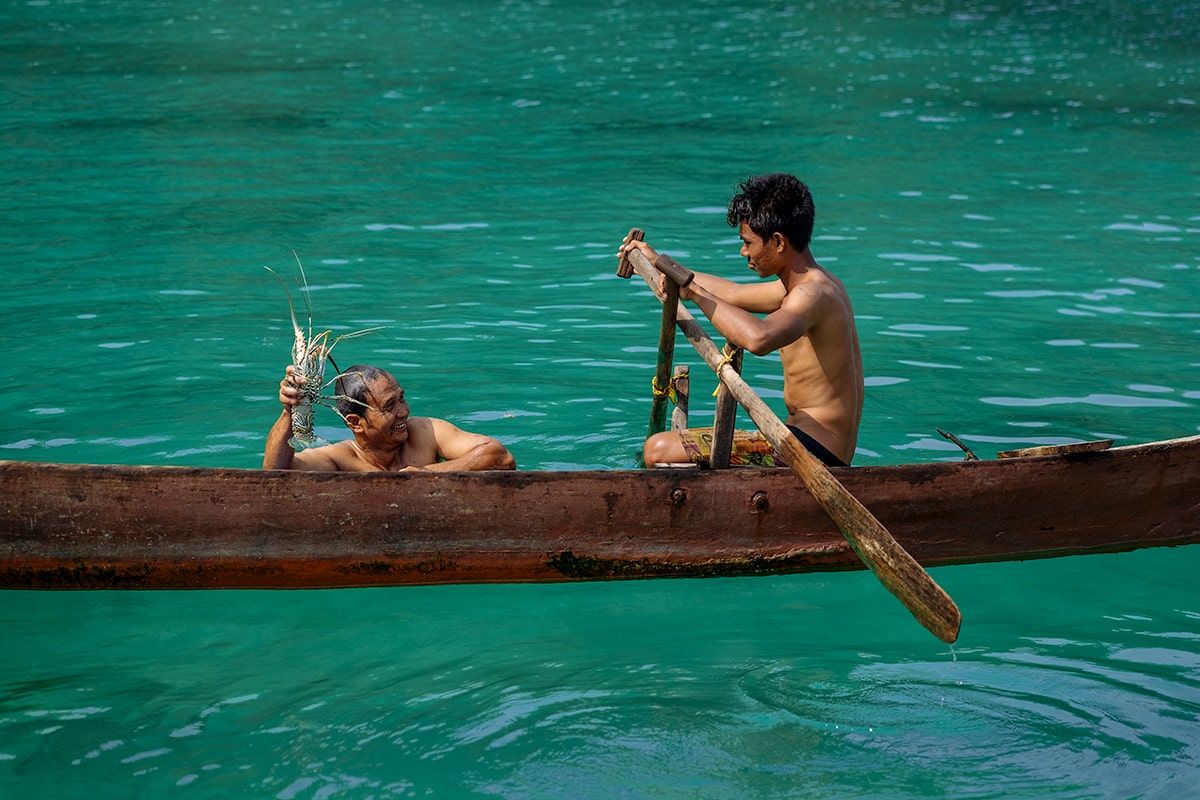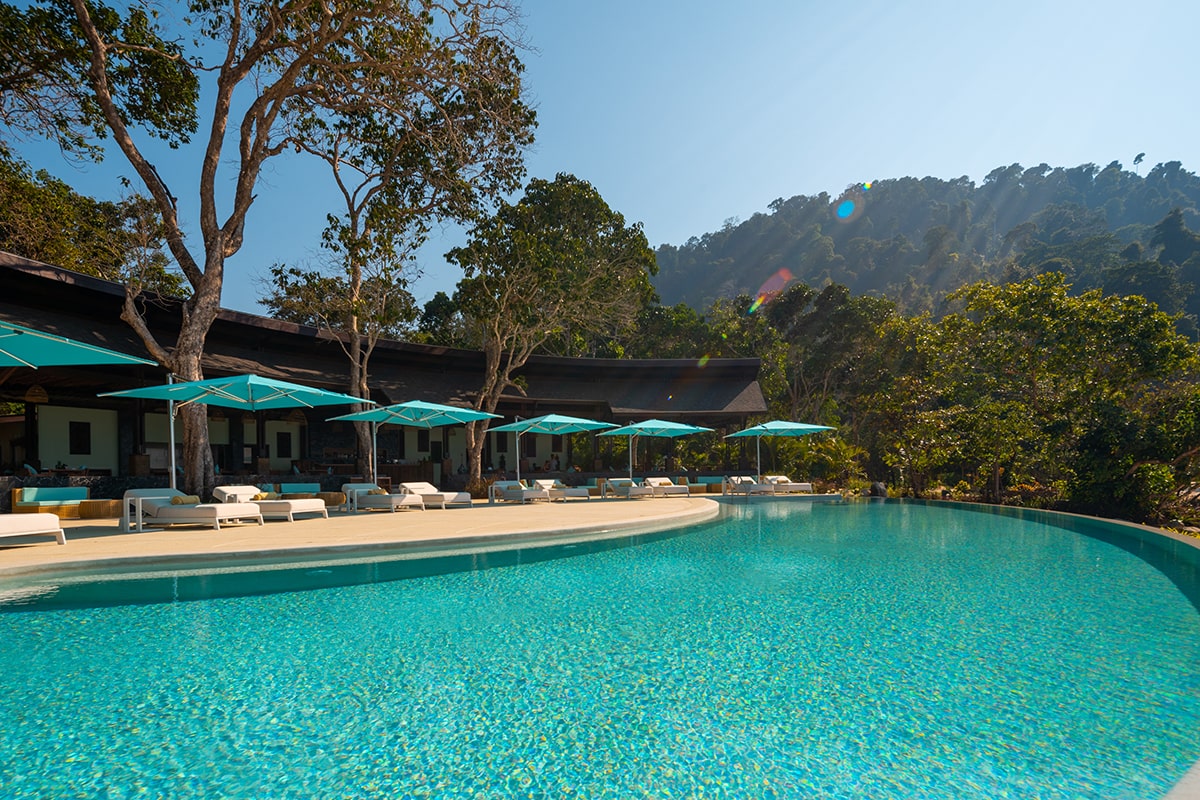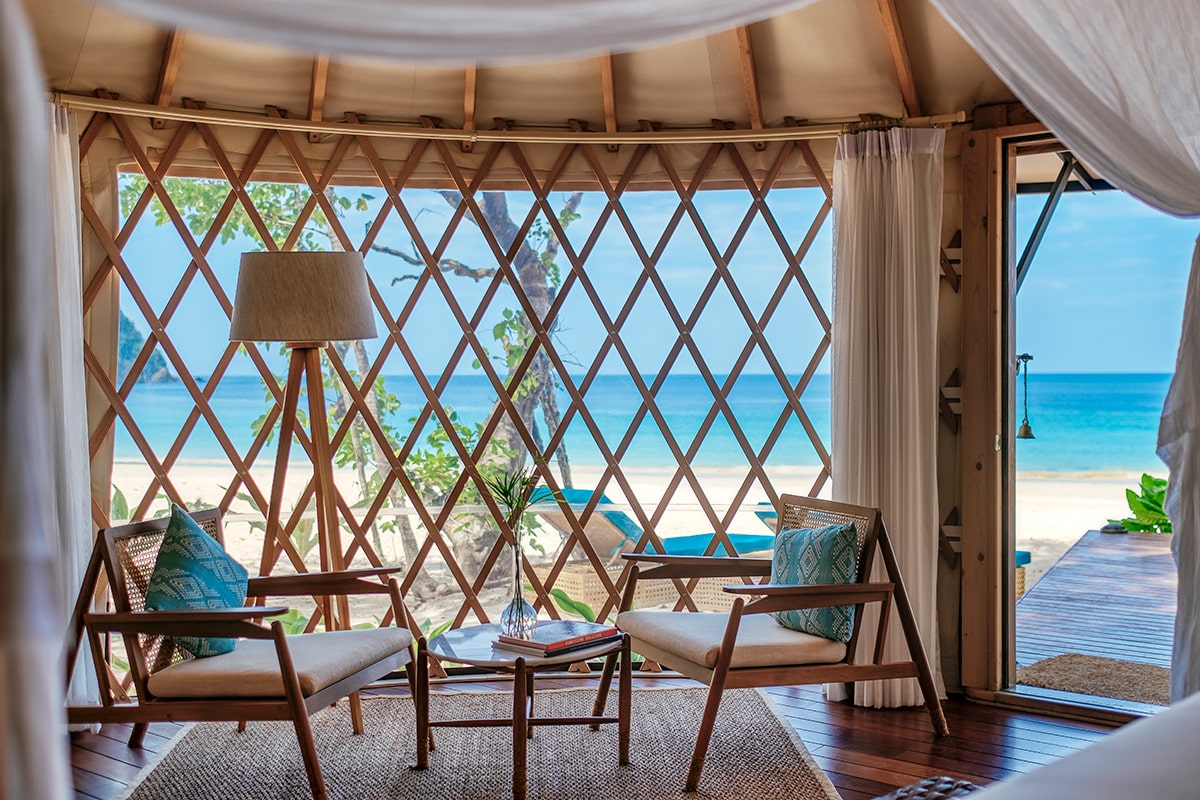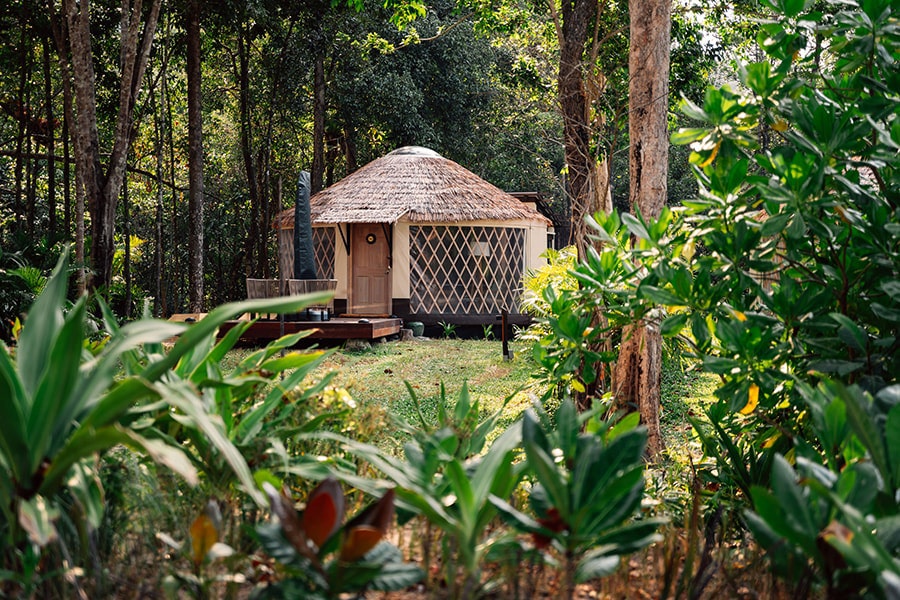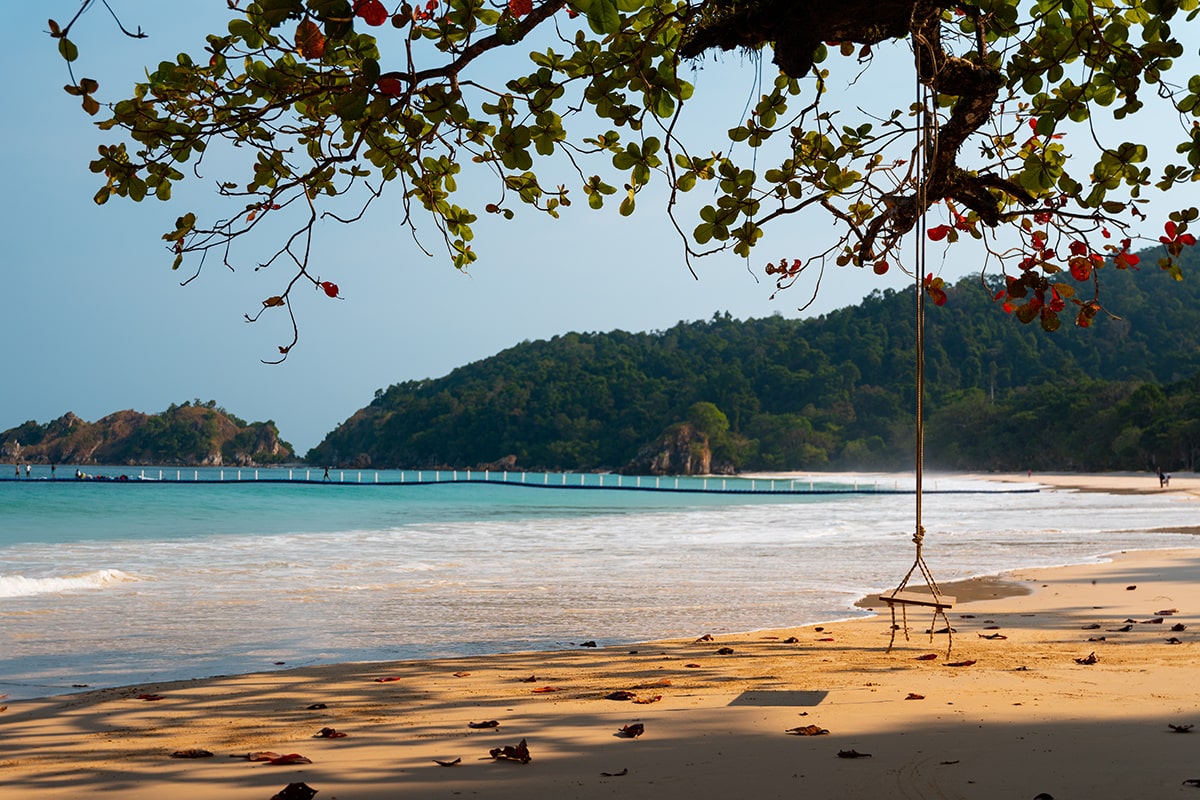DIVE CENTRE
SCUBA DIVING
Our resort offers a 16 square metres reef with depths reaching around 8 meters. This site is full of what the Mergui Archipelago has to offers in terms of sea life. Only a 5 min swim from shore, this coral head and adjacent reef blocks are home to our Coral Out planted reef, where local damaged reef sections are put back in the environment for recovery. Spot our man-made wreck: a small local boat damaged on a previous storm.
Perfect location for trial and orientation dives.
A 3mm shorty or long wetsuit is ideal; a long sleeve rash guard is convenient for snorkelling and kayaking – or to be used together with the shorty. Our models are on sale at the Water Sports Center
Awei Pila Dive Center carries aluminium 12 litres LUXFER tanks with DIN/INT valves, AQUALUNG Regulators, BCD, Computers, Mask & Fins and 3mm Wet Suit Shorties
We do not offer Nitrox dives for the moment.
Awei Pila Resort is equipped with an infirmary and nurse 24/7, all diving and water sports staff are certified in First Aid, and CPR. All boats carry emergency medical oxygen.
Please be aware that the nearest hyperbaric facility is located in nearby Phuket – Thailand approximately 2h by boat plus 3 hours by car.
DIVE SITES
This dive site is a short 20 minutes away from our resort and is home of three different dive sites, including the world famous – Shark Cave. This site is a “must-do” dive for all divers visiting the Mergui either on a liveaboard vessel or on a daily trip.
Here we have the option to dive “The Pinnacle” – “Shark Cave” or “Square Rock” three different sites, which are impossible to be visited in only one dive.
Enjoy big schools of barracudas and yellowtail snappers, loads of scorpionfishes, anemones with different clown fishes inside, squids and eventually stingrays and turtles but not forgetting soft corals, nudibranchs and moray eels.
The Pinnacle
The Pinnacle is the smallest of the three islets and it is known for its huge schools of fish circling this piece of rock that comes from the sandy bottom at 30 meters and goes all the way above the surface.
The dive here goes as a drift dive to be able to enjoy more marine life and to get away from the currents which are normally present. Be careful and stay close to the reef if currents are present.
Schools of bluestripe snapper as well as barracudas are constantly hanging near the surface, watch as well for magnificent soft corals as well healthy hard corals home of angry Domino damselfish.
Along the dive, keep a lookout for how many species of clownfish you spot. Expect to find Clown anemonefish, Clark’s anemonefish & fire clownfish and more.
Keep an eye open Lion Fish and Scorpion fish near the reef crevices, honeycomb groupers are constantly seen together with them and if you like macrophotography make sure to search for nudibranchs like the Blue Dragon and the Varicose Slug among others.
Shark Cave
This site is one of the most famous in the region, the biggest islands of the Three Islets or “Square Island” for some. The island is home to the famed Shark Cave – originally home of some nurse sharks, but today is home of a giant green moray eel and schools of arrow fish.
Even with the sharks not so present nowadays the site remains spectacular. Right at the beginning of the dive, look up for schools of barracudas cruising near the surface and on the wall. Don’t miss the soft corals from different colors, shapes and sizes.
The entrance of the cave is only two minutes away and at 17 meters deep. The entrance is a square shape hole in the wall. Schools of Arrow fish will welcome you at the entrance. Pay attention to the swell, as it might be strong if currents are present. Once inside (torch recommended) look left, right and up, the walls are covered by Orange Cup Coral and sponges.
At the exit on the other side, look for nudibranchs such as the Blue Dragon, the Chromodoris and Flabelina, and when you start to go for your safety stop keep an eye on a small crevice on the reef at around 12 meters where a big Stingray is normally taking a nap inside.
Square Rock
This is the middle size island of the Three Islets and is located further North. This insignificant chalk white rock drops vertically down to about 15 meters before jumbled rocks spread out wider, reaching the sandy bottom at 26 meters. This site is dived in a circular fashion if currents will permit, and there is a smaller sister pinnacle just to the south.
Broadclub cuttlefish are constantly seen in a couple along the reef, while Green Turtles are often spotted passing by. Keep an eye for Fimbriated moray eel, with its typical yellowish head, schools of Bluestripe snappers are always around, eventual Oriental sweetlips and Thumbprint emperor are often seen on top of these boulders. Peacock groupers as well as Honeycomb groupers are always seen, along the Red Lionfish, Broadbarred firefish and sometimes a Scorpion fish. Currents can be fierce here with strong up and down currents.
This dive site is the second most famous in our vicinity and only 30 minutes from the resort. A rocky pinnacle with a rocky bottom going from the surface to 27 meters, Rocky Island is on the North side deeper than the South side of the island. Orange Fan Corals and diverse tube sponges are along the way at 15 meters, black coral and big magnificent anemones with different species of Clown Fish are spread along the reef framing schools of Bluestripe snapper and Brassy Trevallies hunting on small fishes near the surface, mixed with Batfishes.
Green turtles are commonly seen on the North’s more exposed side as well schools of barracudas on the East side of the island, Cuttlefishes in pairs appear along reef crevices and their cousins the Big Blue Octopus usually swim around searching for shells.
Occasionally a blue-spotted ray is seen near the sandy bottom, Peacock groupers, Bicolor parrotfish, Pufferfish and Angelfishes complete the scene on this dive site that can be affected by some strong currents on both East and West ends.
This island is on the west side of Long Bay is the perfect spot for a beautiful and comfortable dive full of colour and a macrophotography delight. The dive starts on the Northern tip of the island – but make sure you watch for some strong currents here and choose to begin your dive on the west side if currents are present.
The reef goes on a gentle slope from the surface down to a sandy bottom at around 18 meters. Here, soft corals (Carnation Tree Corals) in blue, purple and yellow cover the rocks, while under the slopes, Orange Cup corals stay open even during the day.
As you reach the tip of the island, look for Painted Spiny Lobsters, Fimbriated Moray eels and schools of snappers. When you circle the tip, keeping the reef on your left-hand side, you can either maintain the same depth or go down on a rocky, sandy slope up to 27 meters. There, rocky/coral heads are full of life and along the sand looks for the unique Peacock Mantis Shrimp and the Ghost Pipe Fish
Cuttlefish in pairs or hanging on the sand are a constant presence, Honeycomb groupers, Red Lionfish, and the Broad Barred Firefish are usually seen along the bottom.
The dive tends to end around the 10 meters zone where long spire corals are seen, do your safety stop by looking over the big Honeycomb coral heads infiltrated by Christmas Tree worms of different colours.
This is nearby the Lampi National Park, and it is about one hour from our resort, although a long boat trip the ride is well worth as the reef has a magnificent mix of hard and soft corals.
The dive is usually conducted on a drift style starting on further North and coming back keeping the reef on your right-hand side. Along the dive keep an eye on the blue on your left as the channel between Clara and Lampi islands can bring you some surprises.
The reef goes on a slope from the surface to 27+ meters, with coral blocks sometimes seen separated from the main reef. Schools of Brassy Trevallies are constantly seen chasing big schools of baitfish near the surface, while closer to the bottom, schools of yellow snappers hang around all the time.
Big hard coral colonies “Acropora” are present including Table Coral, Wide Star and Finger species, all swarm by groups of Domino Damselfish, Scissortail sergeant the Sapphire Damsel. We cannot forget the Clarks Anemonefish, Fire Clownfish and Clown Anemonefish hidden in different species of anemones along the reef, groupers, Wrasses, Snappers and Emperor fish are just some of the species you will come across along the dive, make sure to finish the dive on the South end of the island where a big table coral full of Soft Corals hang there to say “see you soon” in Myanmar
This site earned its name due to the weird shape with holes above and below water, it is a medium-sized island on the South tip of Bo Wei Island.
The dive starts on a sandy bottom at about 10 meters, Keep to the right of the reef after a few minutes and you will find the main attraction here, a 20 meters long swim through starting at 17 meters and exiting at 20 meters.
As you proceed to enter the downwards entrance, look inside the sea fans for Sea Horses. When going into the cavern, keep an eye for lobsters and other small critters such as Banded Shrimps and Arrow fishes. After exiting, keep the reef on your left until you find another swim through to go back to the original side where you started your dive.
This is a good site for big schools of snappers, lion and scorpionfish, anemone clownfishes and beautiful blue and soft purple corals.
The southern tip of Ba Wei island is home of the pinnacle which emerges from a depth of 35 meters up high into the surface; steep walls hide in their crevices multiple species of nudibranchs and soft corals. Keep the reef on your left and swim down contouring the reef, keep an eye for big schools of pelagic fishes such as fusiliers, yellowtail snappers.
While close to the bottom look for stingrays, moray eels and octopus who populate the sea bed in the area, when you turn around at mid-tank, go up to find a dead-end canyon starting at 12 meters and go up to 8 meters. The site narrows a lot close to the end, but it is worth the sight: plenty of juvenile fishes hide there, search for Oriental Sweet Lips and Angel Fish juveniles as well as blue spotted rays.
The 80-metre island stands in the middle of the ocean. It works as a magnet for fish life who tend pass by the island looking for food or shelter – this includes big pelagic fishes such as Mantas and Whale Sharks, as well as other sharks, rays and schools of jacks, trevallies and yellowtail snappers. The dive goes by taking the reef on your left or right and circling the island and working depths accordingly to your no-deco time as we usually do two successive dives here.
The island stands more or less on a West-East position, and the Northside with its sandy bottom at 35+ meters tend to be a bit shallower than the Southside where big rocks slope down to 40+ meters. But Black Rock is not only about big stuff take your time to look into the crevices to find frog-fish, mantis shrimps and beautiful Nudibranchs on the reef always together with Scorpion fishes and huge Sea Fans.
North Twin Island stands West of Pila and in line of South Twin and Burma Banks an underwater mountain chain that goes parallel to Myanmar’s coastline. The island is big and offers many diving possibilities, but most of the best diving is on the North side facing the currents.
The main attraction here is a submerged reef that starts at 14 meters and goes down to 40+ meters, here big boulders attract a lot of fish life such as big pelagic fishes (manta, whale shark and black tips), big schools swarm the top of the reef and Tuna and Jacks are often seeing hunting on small fishes, near the bottom big moray eels, scorpionfish and soft corals make this dive very colourful and fun.
The NW corner of the island it is marked by big rock boulder sticking out of the water. The dive goes in circles depending on the current and swells a bit away from the main island reef. Here, sandy bottom found at 28 meters together with the excellent visibility makes the perfect spot to look for Eagle Rays cruising along the reef.
Along the dive big boulders with some swim-throughs are scattered around up to 14 meters from the surface, making the perfect hiding place for nudibranch’s, groupers, different anemones and their clownfish and even a ghost pipefish hidden inside the sea fans.
Here, big schools and eventual big pelagic animals can show up. Make sure to keep an eye up!
As the name suggests, this dive site offers outstanding towering walls descending to the depths of the Mergui Archipelago. Sea fans, Whip Corals and Soft corals decorate the walls bringing magical colours depending on the time of the day. Cleaner Shrimps, Nudibranch’s and Angelfishes are always present.
Mantas have been seen in the area, especially during the months of January to March, if they not present, fusiliers, yellowtail snappers will be there in big numbers for sure.
As in any tower, here as well you will find a few swim-through passages, bring your torch and stay close to your instructor. Some can be quite long, and it is important to keep an eye for slippery lobsters and Dancing Shrimps while inside, and look for sharks into the blue waters when exiting.
The name comes from the colour this island becomes during the sunset. Underwater, there is a sandy bottom in one side (south) with big schools of barracudas, jacks sharing the space with sepias, stingrays, lobsters and a multitude of coral reef critters as lionfish, stonefish and clownfishes.
On the Northside and NW corner, big rocks give shelter for lobsters and more schools of fish that will make you unable to see the other side of the reef.
An excellent choice from beginners to advanced divers.

